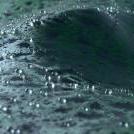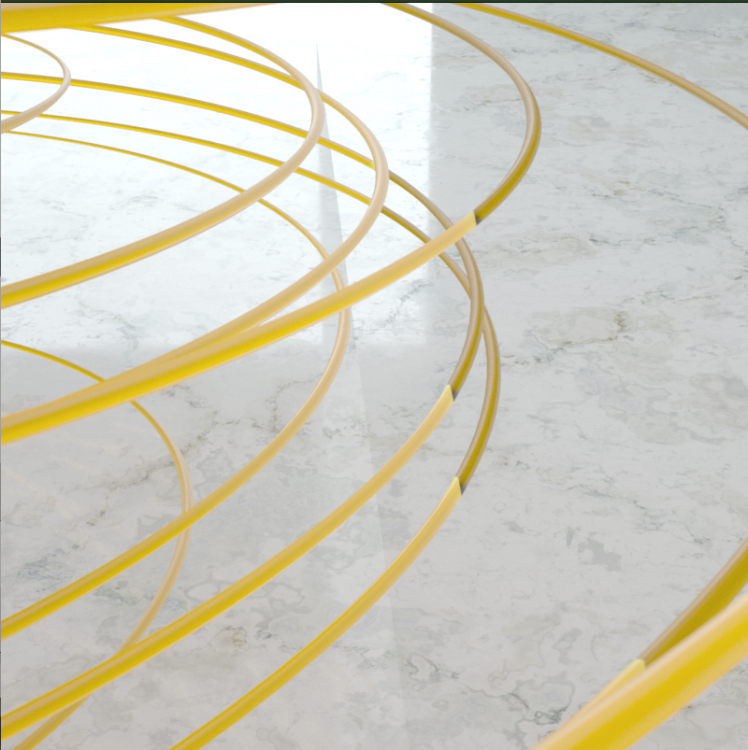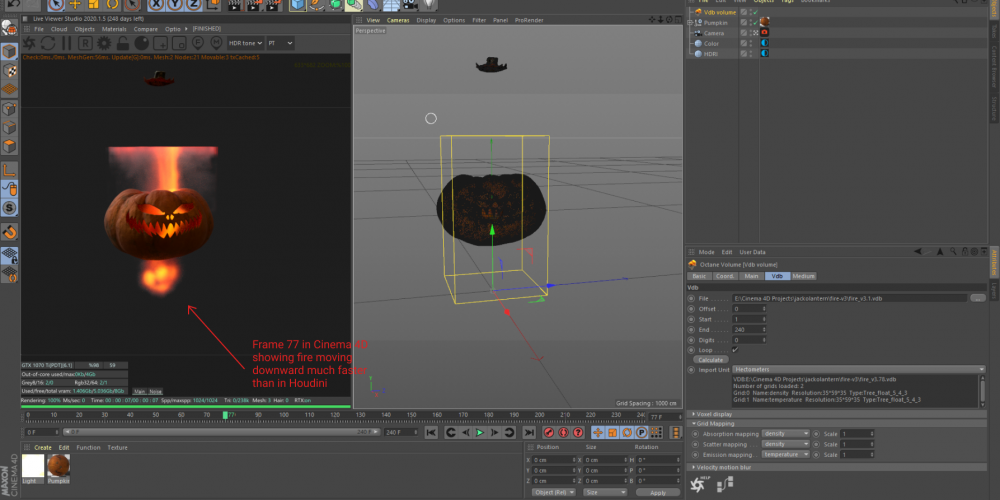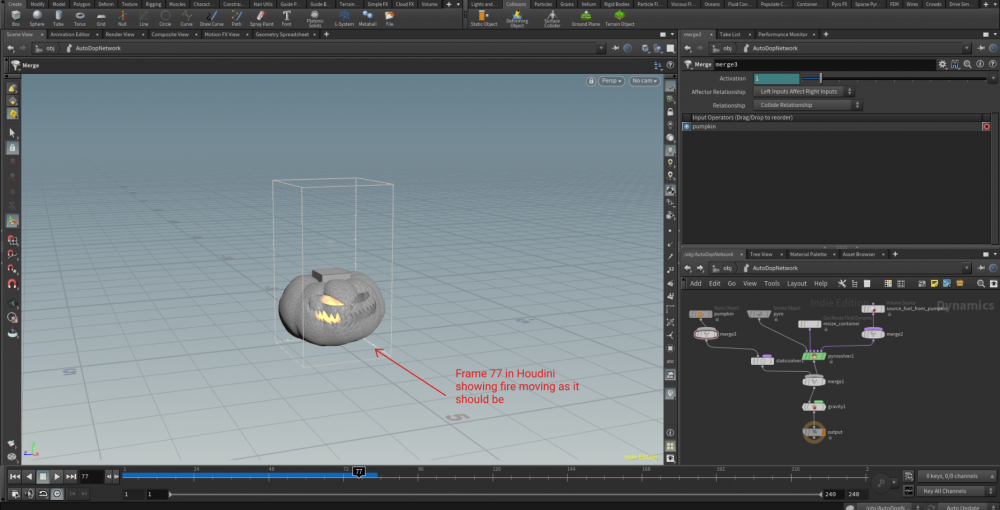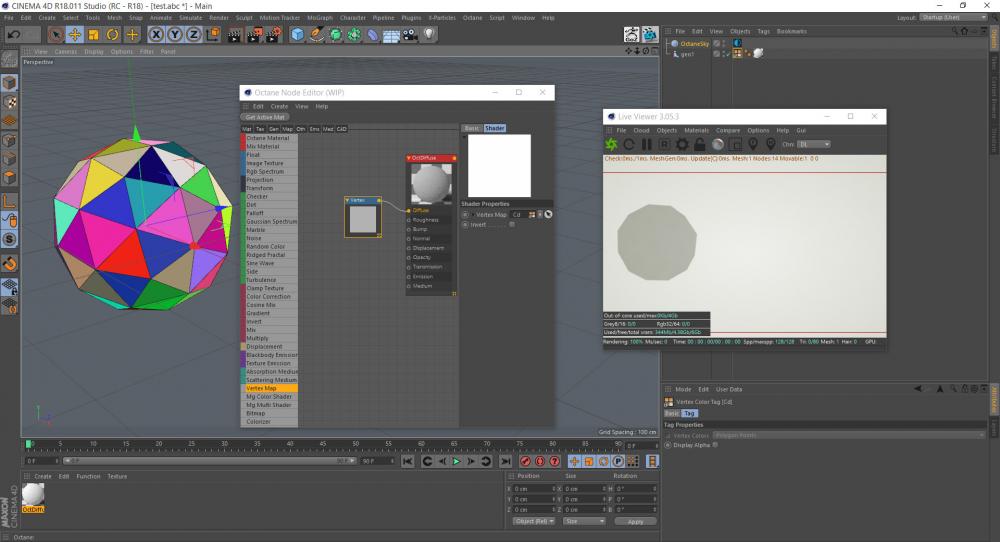Search the Community
Showing results for tags 'Octane'.
-
Is there a way to connect the octane shader in Solaris to a collect node in order to be able to switch between renderers? There is no shader output by default
-
I am trying out Octane in Solaris, but i can't find some of the options that usually live on the obj level, like OpenSubdiv and Tessellations, essentially the object Octane settings. Any idea where are those? Also how can i set the default Octane render settings? Display Options --> Render , is empty (same goes for my HoudiniGL settings, its empty.) Also i had to search in the forums to find the latest OctaneSolarisStudio 2021.1.6.0 for Houdini_19.5.368 its not production ready yet? Sorry lots of questions, i just installed everything and i am trying to establish the basics, like where are all the settings i was using in SOPs
-
Hi, Since almost 2 years, i 'm making some looping GIF using mostly Houdini and octane under the Spyrogif alias. Most of this works are made during various productions to test some Houdini features or while waiting during simulation time. :-) Now i've got a number of those, I thought it might interest you. These tests cover a number of differents technicals approaches and workflows from simple keyframe animation and modelling to fully procedural stuffs. The only thing in common in all these tests is that almost all are using modulo expressions with time blending to get perfects cycles. All these GIF are using a houdini>octanerender via alembic export. The main reason to that is only the fact i like to tweak my render at home and to not overload various postproduction compagnies renderfarm with silly and weird tests. :-) If you want to keep track on this "project" feel free to subscribe to my tumblr. http://spyrogif.tumblr.com/ Edit : You can now follow this on Facebook too. https://www.facebook.com/spyrogif/ Hope you like it. Ps : i'm feeling always guilty to not participate in this forums more. It's a real gold mine and a awsome community (odforce and sidefx forum). Thanks you to everybody, you are awsome. I know that i can always count on you when i struggle with a problem. Thanks for that. Some of them.. More at Spyrogif
- 108 replies
-
- 18
-

-

-
I've start test Houdini 18 and Arnold 6. the first test was simple splines rendering, 250.000 splines instanced 25 times. it loads a 140MB alembic file. rendered in 6 core Xeon CPU and Nvidia Quadro RTX 5000. (windows 10 pro) the startup for Arnold GPU is slow, it renders faster, so it seems but for clear up the final image it takes for forever or just dropped /crashed, hard to tell on the GPU. the CPU is quite fast but much slower then GPU if it ever would finish. (adaptive sampling was on) As soon as Arnold finishes rendering the scene, it stops and do not refresh any more on parameter changes. so far i am not impressed with the Arnold GPU rendering. here is the same scene Arnold CPU with only direct Lighting. (on my MacBook) some test with Arnold GPU. it performed much better with just direct lighting.
-
Hi everyone! I've been stuck on a particular problem today. I've been using a simple voronoi in Houdini to fracture a rock, but I'd somehow like to bake a layered texture or vertex map so you can see the lines emanating from the shell of the model. I've attached a picture of some agate so you can get a better understanding. This is so I can export the alembic into C4D and apply different textures to these 'ridges' using the vertex map, or just a baked texture outright. I'd only need a couple of bands at the outer edges, not going all the way to the center I initially tried converting the rock before the fracture to a volume and baking a ridged texture using the depth from this, but I just can't seem to figure it out. I also tried copying the rock a couple of times, sizing it down a little, then used these copies to bake the vertex colour, but it still wouldn't budge! I'd be very helpful for any tips as it'd be great to get a procedural solution to this problem
-
I’m looking for someone who can convert some OSL code to VEX code. I have a fractal formula written in OSL that needs to be volume density output VEX. For now the simple mandelbulb fractal conversion is enough but I'm looking for someone that could convert many other complex formulas.(200-300 lines of code). New to Houdini, and can't find a way to get this working...after days of looking around, this forum is my last option. OSL CODE TO CONVERT: shader OslGeometry( int Iterations = 10, float Power = 2.0, float Bailout = 20, output _sdf c = _SDFDEF) { vector pos = P; vector z = P; float dr = 1.0; float r = 0.0; for (int i = 0; i < Iterations ; i++) { r = length(z); if (r>Bailout) break; // convert to polar coordinates float theta = acos(z[2]/r); float phi = atan2(z[1],z[0]); dr = pow( r, Power-1.0)*Power*dr + 1.0; // scale and rotate the point float zr = pow( r,Power); theta = theta*Power; phi = phi*Power; // convert back to cartesian coordinates z = zr*vector(sin(theta)*cos(phi), sin(phi)*sin(theta), cos(theta)); z+=pos; } c.dist = 0.5*log(r)*r/dr; } OSL CODE THAT WORKS BUT NEED IT TO BE LIKE THE OSL: function int Mandel(float x0, y0, z0; int Iterations){ float x, y, z, xnew, ynew, znew, n=ch('n'), r, theta, phi; int i; x = x0; y = y0; z = z0; for(i=0; i < Iterations; i++){ r = sqrt(x*x + y*y + z*z); theta = atan2(sqrt(x*x + y*y) , z); phi = atan2(y,x); xnew = pow(r, n) * sin(theta*n) * cos(phi*n) + x0; ynew = pow(r, n) * sin(theta*n) * sin(phi*n) + y0; znew = pow(r, n) * cos(theta*n) + z0; if(xnew*xnew + ynew*ynew + znew*znew > 8){ return(i); } x = xnew; y = ynew; z = znew; } return(Iterations); } //--- Main --- int maxiter = 8; if(Mandel(@P.x, @P.y, @P.z, maxiter) < maxiter){ @density = 0.0; } else { @density = 1.0; } AAND MY CONVERSION THAT DOES NOT WORK function int Fractal(int Iterations, float Power, float Bailout, vector pos, vector z, float dr, float r){ for (int i = 0; i < Iterations ; i++) { r = length(z); if (r>Bailout) break; // convert to polar coordinates float theta = acos(z.z/r); float phi = atan2(z.y,z.x); dr = pow( r, Power-1.0)*Power*dr + 1.0; // scale and rotate the point float zr = pow( r,Power); theta = theta*Power; phi = phi*Power; // convert back to cartesian coordinates z = zr*vector(sin(theta)*cos(phi), sin(phi)*sin(theta), cos(theta)); z+=pos; } return 0.5*log(r)*r/dr; } int Iterations = 10; float Power = 2.0; float Bailout = 20; vector pos = @P; vector z = @P; float dr = 1.0; float r = 0.0; if(Fractal(Iterations,Power,Bailout,@P,@P,dr,r) < Iterations){ @density = 0.0; } else { @density = 1.0; } Thanks in advance. Cheers, Scappin Matteo www.machina-infinitum.com
-
Hello everybody, I'm new here, and i hope i'll be clear to explain you my problem. I made a moving flag on houdini. But now, i try to apply some material to it. But what happen is my material is filling the hole between the moving rope/flag and my flagpole. The Flag is made of two parts: - The rope (on the left in houdini screenshot) - The flag (on the right in Houdini screenshot) The two are merge together, and after i applied some vellum constraints, vellum solver and file cache. It worked with houdini/mantra material, but not with octane. I guess i'm doing something wrong. I let you some screenshot, hope it will help you. Thank you! Take Care
-
Hello dear Computer grahics friends, I wish you all the best for this year, full of RBD destructions, magicals effects, cloth sims ... I start this year with a very boring subject as rendering octane render images using with PDG and HQUEUE on windows 10 My jobs are running successly even if at the end I don't have any output images. Log erros: *** OCTANE API MSG: Could not load 'Q:\RESSOURCES\TEXTURES\EnvMap\substance\sequence\substanceHDR.001.exr:rgba'. [Octane] 12:46:00 INFOR: [save image] -------- Saving the EXR "Q:/PROJECT/dev/04_3D/assets/Exterior/render_farm/MDL/work/houdini/scenes/Model/render/render_farm_Model_withOctaneNode_v001.Octane_ROP1.0001.exr" file *** OCTANE API MSG: OpenEXR: Cannot open image file "Q:\PROJECT\dev\04_3D\assets\Exterior\render_farm\MDL\work\houdini\scenes\Model\render\render_farm_Model_withOctaneNode_v001.Octane_ROP1.0001.exr". No such file or directory. Work around: If i switch manually all my paths from the server letter to the UNC path, evrything work fine. View with the sideFX support, I had HOUDINI_PATHMAP = {'Q:/': '//***.***.*.*/folder','Q:\\': '//**.***.*.**/folder'}. This additional variable fixed this issue to my "houdini nodes" but not for "octane render nodes" If somebody have any idea to fix this issue ? Best regards, Mathieu Negrel
-
Hello, I modeled multiple tubes generated by polywire sop. Although all of the faces' normal is correctly assigned, some portion of the tubes rendered incorrectly (strange looking sss scattering, "broken" appearance, etc.) At first, I thought the problem is caused by overlapping polys because my geo has quite a complex shape. So, I tried removing overlapping polygons using Boolean sop and removing degenerated prims using clean sop. But the result didn't change. I'd like to know what should I do to render the geometry correctly. I attached the hip file. (polywire.hiplc) Thank you.
-
I have been banging my head on my keyboard for a bit on this one. I have exported an alembic file consisting of an object that bounces up and down. I then export that object to Houdini where I perform a very basic fire simulation on the object. I then export the fire sequence out as a vdb where I import it into Cinema 4D and display the vdb with Octane render. Everything looks great the only problem is the fire object moves faster than the initial object. This should not be possible considering the fire's position is based on the position of the object. Does anybody have any suggestions on how I can fix this? *Both alembic, Cinema 4D, and Houdini files are all based on 24 frame rate
-
Sup guys, anybody knows how to read houdini color attributes in octane for c4d? I tried exporting as alembic, that gave me a vertex color tag wich I plug into a vertex map on a material, but isn't working, the native c4d render seems to load it, any tips on this? Thanks!
-
Hi guys, I made this simple sim in Houdini and exported it to C4D to render with Octane V4 as alembic. The problem is that in the first frames, there are those weird polygons on the mesh, maybe normal problems? I didn't manage to fix it so I'm ask if anyone here had this problem before and knows a solution for it. I will attach the render and my hip filie below. Thanks in advance. RnD_Viscous.v0.hip lan_rnd_sorvete.mov Edit: I'm sorry admin I messed up with the replies.
-
Hello, I can't figure out how can I reference houdini attributes in the octane network material. I see there are two nodes called "Color Vertex Attribute" and "Float Vertex Attribute" but I don't know how to use them or reference the attribute I want. I can't find anything about them in the documentation either. Does anyone know how to do this?
-
Hello everyone, The primary aim of this training is to provide a project that will take the viewer through as much of Houdini as possible. Letting them utilize all the various tools that Houdini provides for modeling and VFX to generate a detailed environment. Currently the training is available for redshift and octane. Next week, I'll be recording the mantra version. There is a 25% introductory discount in the entire training till 18th may 2019 Click on the link given below for more information http://www.rohandalvi.net/rocketbus
-
- 2
-

-
- rendering
- instancing
-
(and 6 more)
Tagged with:
-
Does anyone know how to do a proper UDIM Setup in Octane with the Texture UDIM Node?
-
Hi everyone, I got an issue with rendering a Lot of Spheres in Octane. I scattered 1 million points on a surface and copied Spheres on it (with the CopyStamp SOP). I packed it but it does not render and crash. Can somebody tell me how i can render Instances in Octane or point out some Informations, i can't figure out how to do it right due im new to Houdini and Octane. Cheers!
-
Hello everyone, I'm starting with Houdini and Python and I have a doubt which would influence my learning curve significantly. I'd like to know if someone has specific information about reaching the transformation matrix of particles in Houdini - preferably in Python. From the SideFx Python Documentation says it's not yet implemented. I also read somewhere here that it's possible through VOP/VEX. The objective is to make a particle export script from Houdini to Octane's CSV - to adapt Houdini to an existing workflow. This CSV file only has these particle's transform matrix. And it would have to be usable, for example, for 5 million particles. Does anyone has any tips? Or in alternative if someone has this script already, it would be great! I'm not a coder (MaxScript only) and it will take me ages to get it done... Thanks in advance! M
- 7 replies
-
- transform matrix
- octane
-
(and 2 more)
Tagged with:
-
Hi guys, Does anyone know how to do an HDRI render in octane with transparent or HDRI-less background? Forgive me, as I searched for this answer and could not find it anywhere... Cheers and thanks! T
-
Hello Everyone, This training is will cover the new height field tools introduced in Houdini 16. The training comprises of 5 projects that will cover techniques to create a variety of terrains. Over the course of the projects the videos will cover a majority of the heightfield tools such as noise, pattern, mask by feature, heightfield layer, erode, heightfield wrangle etc. The training is available for Redshift, Arnold, Octane and Mantra. For more information kindly click on the link given below http://www.rohandalvi.net/terrains
-
Hi, This would technically be my first fan art in Houdini. Usually I make all of my fan arts in Daz and use Houdini to do some additional modelling since you can't model in Daz. This time I went the other way around primarily because I wanted to try the new Hair tool in Houdini 16. Which, by the way, are fantastic. The character and clothing were posed in Daz and exported as obj to Houdini. Hair and the rest of the scene is Houdini. Skin and hair shader is custom because octane doesn't have a skin or a hair shader. For my next one I'll try the new auto rigging tools on Houdini.
-
I almost never rendered with Houdini but thought of giving it a try... Essentially I created an Octane material and applied it to my geometry but I want the diffuse colour of the shader to be the colour of my points geometry (and not the colour selected in the shader node). Im assuming it's a pretty basic thing but couldnt find a way to do it (played with material override etc.) ... maybe Mantra gets it automatically (seems a sensible thing) but not Octane. In layman's terms I coloured a series of geometries using some gradients and random values (my points have @Cd attributes). Then I created a standard Glossy Octane material. I want my objects to have the properties of the Octane shader (reflection, roughness, opacity, ...) but use the @Cd attributes in the geometry to drive the diffuse colour. Thanks!
-
Hello Everyone, This training is an update to the Tea and Cookies training. The training covers fairly similar topics such as modeling, shading, lighting and rendering. The primary difference is that instead of Mantra the training focuses on using the third party render engines namely, Redshift, Octane and Arnold. The modeling part of the training covers a variety of techniques ranging from basic poly modeling, VDB, fluid simulations and even POP grains to build the scene. This shading and lighting part primarily focuses is on building all the various shaders required for the scene using a variety of procedural textures and bitmaps. The training will also cover SSS, displacement and building fluid shaders using absorption. We will also build relatively detailed metal and plastic shaders. Trailer for further details kindly click on the link given below http://www.rohandalvi.net/dessert/
-
Hello Everyone, A couple of renders done using Houdini and Octane. Rendered using a single GTX 1080. The render time is relatively high but I love the look. The nebula render has very little post production. The cloud render was tweaked a little in photoshop using Color Efex pro. These are part of a new training series on volumetric rendering. Nebula - Render time - 1 hr 50 min at 4K resolution Clouds - Render time 45 min for Full HD
- 7 replies
-
- 4
-

-
- octane
- octane render
-
(and 1 more)
Tagged with:
-
Hello everyone, This training is a series of small projects that will cover the process of creating a variety of volumetric effects in Houdini and rendering them using Octane. This training is primarily focused on modeling and rendering custom volume effects. Over the course of this training I'll cover a variety of effects which include building and rendering clouds, making a pyro shader and using the blackbody emission to control the pyro shader. We'll also build custom volume effects such as a gas flame and a nebula. Finally we'll take a look at building controllable volume lights and volume fog. NOTE: Additional lessons for Redshift and Mantra will be added to this training towards the end of October. (They will be available separately for download depending upon your renderer of choice. These parts will be charged separately.) For further details click on the link given below http://www.rohandalvi.net/volumetrics



